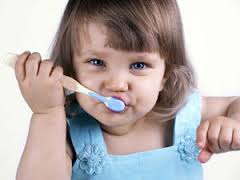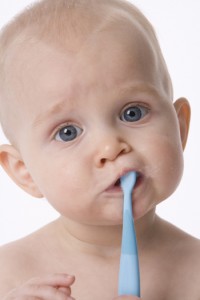
Regular tooth brushing is important for children to maintain healthy teeth but can be a challenge for parents of children with special needs. Visiting the dentist is important to and can be stressful, even for adults, but it presents a range of challenges for children with special needs. Here are some ideas to help make these processes easier:
1. Establish a regular routine. Children accept things more easily when it is a consistent part of their daily routine. Try to brush twice per day at a fairly consistent time. Try not to skip sessions as this may make the next session harder.
2. Gradually introduce your child to the process. Move from step to step when your child seems ready for a new challenge.
3. Model to your child. Allow your child to watch you brush your teeth as they chew on a toothbrush themselves.
4. Familiarise your child with the idea of tooth brushing. Check your library for books on tooth brushing. YouTube has kids songs and videos about tooth brushing. Look and find one that appeals to your child. There are also apps about tooth brushing on the app store which can help familiarise your child with the idea. Why not make a video of family members going through the process of brushing their teeth and let your child watch it over until they are familiar with what happens.
5. Use a visual schedule to show your child the steps involved. Talk to your child's speech pathologist or OT if you need help with this. For reluctant brushers you could also use a "first then" schedule and include a fun reward for completing brushing such as "first we brush your teeth and then we can play trains". Older children can use a reward chart to encourage regular brushing.
6. Consider the impact of your child's sensory issues and speak with an OT about ways to manage these.
7. Experiment with different types of toothbrushes, including toddler brushes and electric toothbrushes, which can make the process quicker and more effective.
8. Consider different types of toothpaste. Children's toothpaste has a milder taste and fluoride free toothpaste is safer if your child is not able to rinse and spit effectively.
9. Understand about tooth decay. This is a preventable disease caused by bacteria in the mouth. Sugary foods feed the bacteria and increase decay. Extended drinking from a baby bottle can increase tooth decay so try to move children onto a cup as soon as possible and offer water after milk or sugary drinks.

Introducing tooth brushing
1. You can begin by introducing rubbing a soft, wet cloth over your babies gums after a feed even before they have teeth.
2. Once your child has teeth try rubbing them gently with a small, soft child's toothbrush with water only. Don't use toothpaste until your child can rinse and spit.
3. If your child has difficulty tolerating a toothbrush you could begin with encouraging chewing on a wet cloth, then rubbing this around the mouth and over the teeth, then moving to chewing on a toothbrush and finally brushing with a toothbrush.
4. Next introduce sipping water and spitting. Introduce children's fluoride free toothpaste initially and when your child can rinse and spit well move to a fluoride toothpaste.
5. Gradually increase the amount of toothpaste from a tiny smear initially to allow your child to get used to the taste until you reach a pea sized drop.
6. Children can begin to brush their own teeth from around 2 or 3 years, though some children may need to be older. They won't be able to do it thoroughly though so you will need to let them brush then finish of for them to make sure all food and bacteria is removed. Children may not be fully independent until around 6 or 7 years and even then they may need some supervision and reminding.
This page has advice for children with physical disabilities including how to adapt toothbrushes for children to hold more easily and how to position children for tooth brushing. http://uscm.med.sc.edu/oralhealth/oralhealthp1_files/page0004.htm
Visit a dentist regularly. The SA dental service provides free services to children under 18 in South Australia. Click here for details of this service. Mention your child's special needs when you book. Alternatively ask other parents or your therapist if they can recommend a dentist that is good with children with special needs.

Preparing your child for a visit to the dentist:
1. Talk to the dentist about your child's needs at the time of booking. Ask the dentist if they have exprience with children with special needs similar to your child and what they do to help them feel comfortable.
2. Use a book or a social story. Young children may like a simple picture book about going to the dentist. Older children may like factual, science books that explain why looking after your teeth is important.
3. Begin with taking your child with you when you visit. Let them see the room, watch what happens and practice sitting in the chair. Bring an extra adult if needed to take your child out if they get restless and remember to be a calm, brave model for your child! You can also use this as an opportunity to take some photos and make a social story for your child to prepare them for their own visit. Also make a note of any sensory stimulation that may be an issue for your child so that you can plan for this at their visit.
4. Talk to your OT about any sensory issues. Sunglasses may help with bright lights, earmuffs or ipods may help with noise, sniffing a tissue with a pleasant essential oil may help with unusual smells. Your OT will be able to suggest ways to help your child feel calm while sitting in the dentists chair.
5. Bring a favourite toy or activity to act as a calming influence or a distraction, such as a favourite teddy for a younger child and an ipod or ipad for an older child.
6. Plan a positive reward for your child for completing their trip to the dentist.
Children with special needs sometimes need individualised support based on an assessment of their abilities and challenges. If you need support helping your child with tooth brushing an appointment with an occupational therapist can be invaluable.
Talking Matters provides speech pathology and occupational therapy services to children of all ages. To find out more about our speech pathology services click here. To find out more about occupational therapy click here.
To find out more about Talking Matters visit us on our website, Facebook page, Twitter, or Pinterest.
Good luck caring for your child's smile!
Related Blog Posts
If you liked this post you may also like:
Learn by playing? Imagine that!
Tantrums and meltdowns 101
Outdoor learning 101
Case Study Thon Alou



